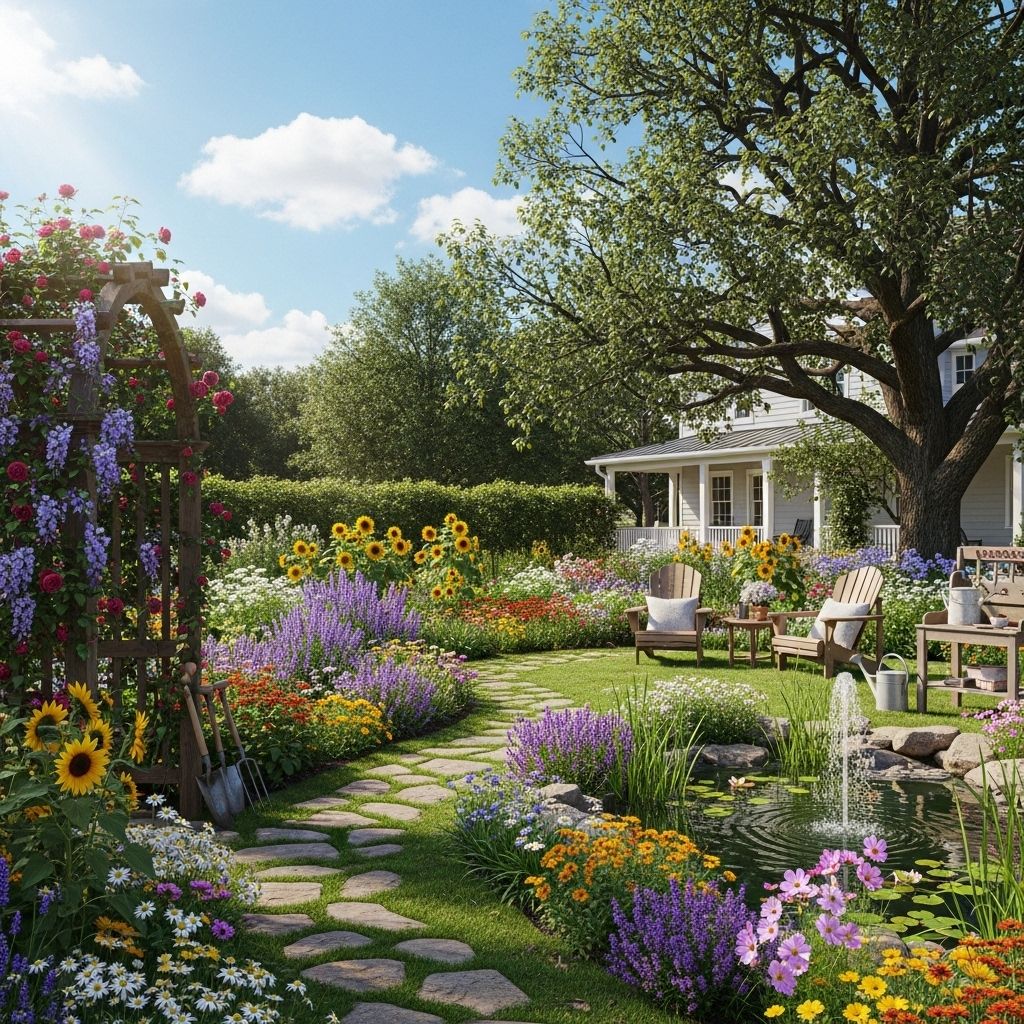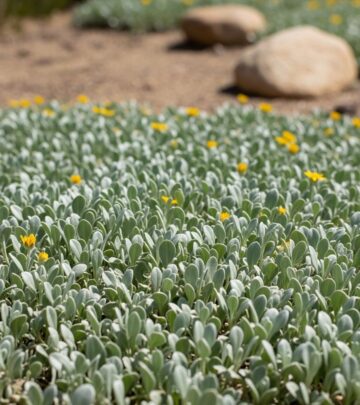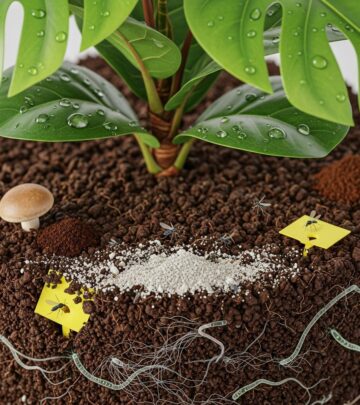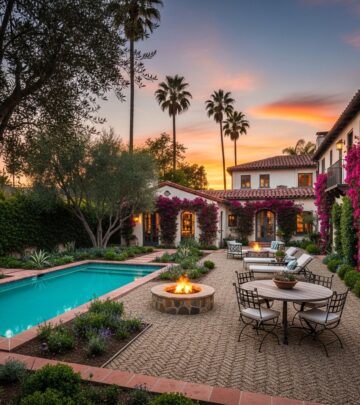Farmhouse Garden Design: 7 Tips For An Inviting Outdoor Oasis
Transform your outdoor space into an immersive farmhouse garden that invites exploration and celebrates natural beauty

Image: HearthJunction Design Team
Farmhouse Garden: Creating a Space to Explore and Experience
The art of designing a farmhouse garden lies in creating a space that feels both authentic to the property’s heritage and invites visitors to wander and discover. When landscape designer Donald Pell of Donald Pell Gardens Landscape Design in Phoenixville, Pennsylvania, approached this colonial farmhouse project, he faced a unique challenge: create a garden from scratch for homeowners who had spent 30 years restoring their historic home but had never established a garden.
“The owners had restored this farmhouse over a period of 30 years. Since owning the home, they had never had a garden, but were now ready to build one, and they wanted to be able to manage it themselves as much as possible,” explains Pell. His solution perfectly balanced beauty with practicality: “I composed the plantings in sweeping masses so it would be very legible, which simplified the maintenance by making it easy for the homeowners to quickly identify any species that seeded in and didn’t belong.”
Throughout this Pennsylvania garden, careful attention was paid to creating what the owners beautifully describe as “walking through a symphony.” This poetic vision was realized through thoughtful design choices that not only enhanced the aesthetic appeal but also improved accessibility and created intimate spaces for entertaining and relaxation.
Design Principles for a Harmonious Farmhouse Garden
Creating a garden that feels authentic to a farmhouse property requires adherence to several key design principles. The most successful farmhouse gardens, like the one featured in this Pennsylvania project, seamlessly blend with both the architectural style of the home and the surrounding landscape.
At its core, a farmhouse garden should feel natural and unforced. This doesn’t mean it lacks design intent—quite the opposite. Every element is carefully considered but presented in a way that feels organic and evolved over time. This approach honors the agricultural heritage that farmhouses represent while creating a space that meets modern needs for outdoor living and enjoyment.
The Pennsylvania farmhouse garden exemplifies how to balance formality with naturalistic planting. By using authentic materials—like hand-cut salvaged fieldstone—alongside sweeping masses of native and adaptive plants, the garden achieves a timeless quality that respects the home’s colonial roots while creating a functional and beautiful space for today’s lifestyle.
Seven Strategies for Creating a Garden to Explore
The most engaging gardens invite exploration and discovery. In the Pennsylvania farmhouse project, several key strategies were employed to create an immersive experience that unfolds gradually as visitors move through the space. These approaches can be adapted to gardens of various sizes and styles:
1. Use Authentic Materials
For garden patios and pathways, select hardscaping materials that reflect both the surrounding landscape and the architectural character of your home. The Pennsylvania farmhouse garden features hand-cut salvaged fieldstone throughout, which is not only authentic to the colonial period but also evokes the materials traditionally used in gardens of that era. This choice creates visual continuity between the home and garden while honoring the property’s historical context.
2. Create Mystery with Winding Paths
One of the most effective ways to encourage garden exploration is to design pathways where the destination isn’t immediately visible. In the featured garden, winding paths with gentle curves keep visitors intrigued about what lies around the next bend. This approach feels more natural than straight pathways and creates a sense of journey and discovery as one moves through the space.
3. Embrace Native Plantings
Native plants not only thrive with less maintenance but also create an authentic sense of place. The Pennsylvania garden extensively uses native species that naturalize over time, creating the experience of walking through a meadow. These plants attract local pollinators and birds, filling the garden with movement and sound that further enhances the immersive experience.
4. Design for Seasonal Interest
A truly successful garden offers something to enjoy throughout the year. By selecting plants with varied blooming periods, interesting seed heads, colorful fall foliage, and winter structure, the farmhouse garden remains engaging across all seasons. This approach ensures the garden is never static but continually evolving, offering new discoveries with each visit.
5. Create Intimate Gathering Spaces
Thoughtfully designed seating areas invite people to linger and enjoy the garden from different perspectives. In the Pennsylvania farmhouse project, several intimate outdoor rooms were created, providing spaces for both solitary reflection and social gatherings. These areas are positioned to capture the best views while offering a sense of enclosure and comfort.
6. Incorporate Water Features
Water elements add another sensory dimension to garden experiences. Whether a formal fountain that references historical design traditions or a more naturalistic feature that mimics streams found in the surrounding landscape, water brings movement, sound, and reflective qualities that enhance the overall garden atmosphere.
7. Plan for Manageable Maintenance
As with the Pennsylvania farmhouse garden, designing with maintenance in mind ensures the space remains beautiful over time. By planting in sweeping masses that make it easy to identify which plants belong, the designers created a garden that the homeowners could largely maintain themselves. This consideration is essential for long-term garden success.
Plant Selection for Farmhouse Gardens
The plant palette for a farmhouse garden should strike a balance between structure and spontaneity. In the Pennsylvania project, plants were selected for their diverse morphology, seasonal interest, and ability to create a cohesive composition while still allowing for natural interaction between species.
Native perennials form the backbone of the garden, creating sweeping drifts that mimic natural meadow landscapes. These are complemented by ornamental grasses that add movement and sound as they respond to the slightest breeze. Flowering shrubs provide structure and seasonal focal points, while carefully selected trees frame views and create a sense of maturity.
The designer favored plants that would naturalize over time, creating a garden that develops its own character while remaining manageable. This approach allows the garden to evolve naturally while maintaining the original design intent, creating a space that feels both designed and spontaneous.
Hardscaping Elements in Farmhouse Garden Design
The hardscaping elements in a farmhouse garden should complement both the architectural style of the home and the natural landscape. In the Pennsylvania project, hand-cut salvaged fieldstone creates paths, walls, and patios that feel authentic to the colonial-era farmhouse.
These elements serve both practical and aesthetic purposes. Pathways improve accessibility while guiding the garden experience. Walls define spaces and create level changes that add interest to the garden topography. Patios provide places for gathering and enjoying the garden from different perspectives.
The irregular, handcrafted quality of the stonework contributes significantly to the garden’s charm and authentic character. Unlike machine-cut materials, these stones bear the marks of human craftsmanship, creating a connection to traditional building techniques that would have been used when the farmhouse was originally constructed.
Creating a Resilient Garden Ecosystem
Beyond aesthetics, the Pennsylvania farmhouse garden was designed as a resilient ecosystem that responds positively to environmental stress. This approach not only creates a more sustainable landscape but also reduces long-term maintenance requirements.
The garden incorporates diverse plant communities with species selected for their complementary growth habits and competitive balance. This diversity helps the garden withstand challenges like drought, pests, or disease that might devastate a monoculture planting.
Soil preparation played a crucial role in establishing this resilient system. Before planting, soils were properly fractured to ensure good drainage and root development. Mulching was strategic, using a mix of wood chips and leaf compost for woody plants while establishing herbaceous plants directly in prepared soil or with minimal natural mulch.
Plants were also selected for their habitat value, providing food and shelter for pollinators, birds, and other wildlife. This ecological approach creates a garden that not only looks beautiful but also contributes positively to the local environment.
Frequently Asked Questions
Q: How can I make my farmhouse garden easier to maintain?
A: Plant in sweeping masses of the same species, which makes it easier to identify plants that don’t belong. Choose native and adaptive plants suited to your local conditions, as they typically require less intervention. Establish clear garden edges and use appropriate mulching to minimize weeding.
Q: What hardscaping materials work best for a farmhouse garden?
A: Locally-sourced natural materials like fieldstone, flagstone, and gravel are ideal for farmhouse gardens. Look for materials with an irregular, handcrafted quality that complement the architectural style of your home and reflect materials traditionally used in your region.
Q: How do I create paths that encourage garden exploration?
A: Design winding paths with gentle curves where destinations aren’t immediately visible. This creates mystery and encourages visitors to discover what’s around the next bend. Vary path widths to create rhythm and use appropriate materials that feel natural in your landscape.
Q: Which native plants work well in a farmhouse garden?
A: The best natives depend on your specific region, but look for plants with diverse morphology and seasonal interest. Include a mix of flowering perennials, ornamental grasses, shrubs with berries or interesting bark, and trees that provide structure. Consult with local native plant societies or extension offices for recommendations specific to your area.
Q: How can I create outdoor rooms in my farmhouse garden?
A: Define spaces using a combination of structural elements like low walls or hedges and changes in materials or elevations. Position seating areas to capture the best views while providing a sense of enclosure. Consider how these spaces will be used throughout the seasons and design accordingly, incorporating features like fire pits for extended seasonal use.
References
- https://www.gardendesign.com/pennsylvania/farmhouse.html
- https://www.gardendesign.com/pennsylvania/
- https://www.naturesaccentslandscape.com/blog/5-farmhouse-landscaping-ideas-for-your-lebanon-pa-backyard
- https://www.instagram.com/reel/DJaWodYNpQh/
- https://nativegardendesigns.wildones.org/designs/philadelphia/
Read full bio of Shinta












